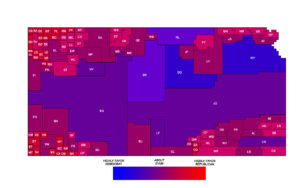 We had an unusually large number of Kansas House races that were remarkably close and those that are looking at absentee and provisional ballots as a result are now becoming closer to resolution.
We had an unusually large number of Kansas House races that were remarkably close and those that are looking at absentee and provisional ballots as a result are now becoming closer to resolution.
In House District 72, on election night incumbent Democrat Tim Hodge was down by 84 votes. After the canvass, Hodge was found to have won re-election by 92 votes.
In House District 111, Democrat Eber Phelps was down by 40 votes to Republican challenger Barbara Wasinger. After the canvass, Wasinger’s lead was whittle down to 32 votes. Phelps has asked for this race to go to a hand recount.
In House District 48, Democrat David Benson was ahead on election night by 36 votes over incumbent Republican Abraham Rafie. After the Johnson County canvass was completed, Benson had won by 82 votes.
In House District 25, Democrat Rui Xu was ahead of incumbent Republican Melissa Rooker by 51 votes on election night. After the Johnson County canvass was completed, Xu had won by 121 votes.
At this point, the Democrat/Republican balance in the House would appear to be unchanged from 2017-18. Democrats lost five incumbents but elected five challengers over Republicans. The House will most likely be 40 Democrats and 85 Republicans. It is still possible that Phelps could win re-election in HD 111. If he does, the divisions would be 41 Democrats to 84 Republicans.
What Color is Kansas?
Pundits and broadcasters often refer to Kansas as a “deep red” state meaning that it is so Republican that Democrats are very unlikely to ever win. And yet when Kansans elect Governors, an interesting phenomenon occurs – one that even Kris Kobach noted in his concession speech on election night. Since 1954, no Republican governor has been succeeded by another Republican and no Democratic governor has been succeeded by another Democrat.
When you look at county by county election maps, it would appear that Kansas is deeply red. But in reality, Kansas is far more “purple” than one might think.
Kansas State Representative Adam Smith (R-Weskan) comes from one of reddest areas in our state. Smith thought it would be interesting to take a closer look at Kansas and consider things like population density and actual voting trends to make a new electoral map of Kansas and the results are fascinating.
When Smith looked at the two counties that appear the reddest (Wallace and Wichita Counties) and the two that appear the bluest (Douglas and Wyandotte Counties), he noted that those two red counties delivered a total of 1279 votes while those two blue counties delivered 81,762 votes. This explains why a state-wide Democratic candidate can win nine counties and win over a Republican taking 96 counties. The nine counties won by Democrat Kelly are, for lack of a better expression, “where the people live.”
So Smith adjusted the map in two ways. First, he made the size of counties proportional to their population. Johnson County becomes very large while Wallace County shrinks. Secondly, he put the counties on a color scale from deep red to deep blue based on the ratio of votes cast for Republican candidates to votes cast for Democratic candidates. If the ratio is 9:1 Republican, the county is deep red; if 9:1 Democratic, the county is deep blue. A 1:1 ration would be purple.
The resulting map is fascinating! Kansas would appear to be a very purple state – a centrist, moderate state. Take a look:
If you want to read Representative Smith’s full explanation, click here!



